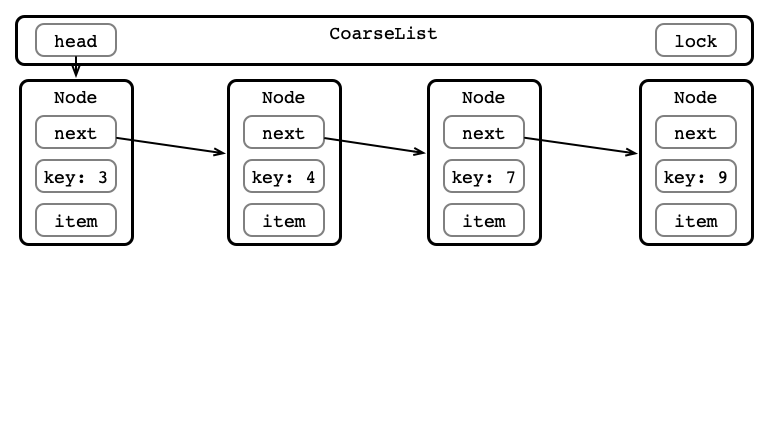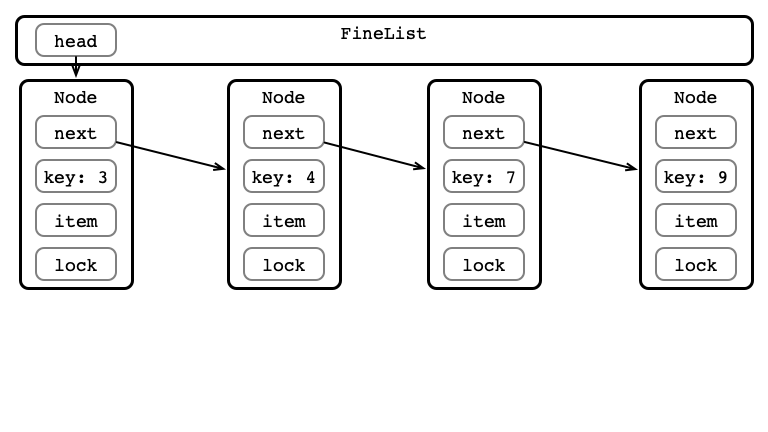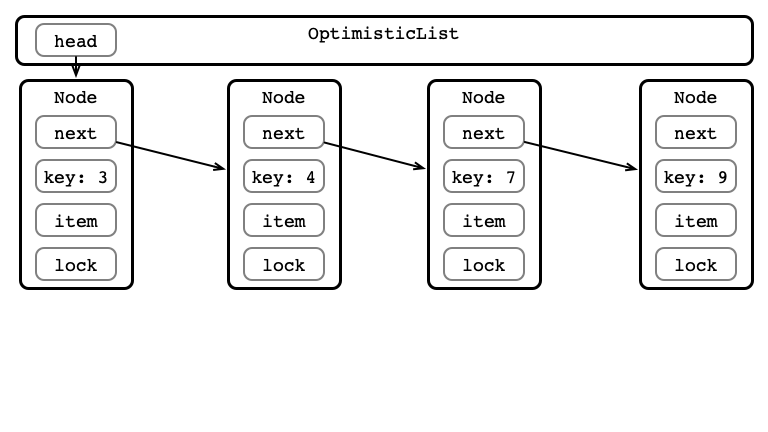Lecture 16: Concurrent Linked Lists
Overview
- Lab 04 Tips
-
Setas a Linked List - Synchronization Philosophies
- Coarse-grained Linked List
- Fine-grained Linked List
- Optimistic Linked List
Lab 04 Tips
Prime Tasks
Suggested structure:
- Compute small primes (up to
Math.sqrt(MAX))- use
Primes.getPrimesUpTo(int max)
- use
- Use small primes and SoE to find rest of primes
- consider a block
[n, n + k]of numbers fromnton + k - for each small prime
p, remove multiples ofpfrom[n, n + k] - remaining numbers are prime
- consider a block
- Write primes from step 2 in order to
primesarray
Have a dedicated thread for step 3; use several threads to perform step 2 in parallel
Prime Tasks in Pictures
Performance Optimizations
- Use reasonably small objects
- several smaller tasks/arrays are better than few larger ones
- arrays should fit in low-level cache
- Minimize sharing of objects
- each object should be written by one thread, and read by at most one other thread
- think of “passing” completed tasks from producer to consumer
- limit concurrent access
A Set
A Set of elements:
- store a collection of distinct elements
-
addan element- no effect if element already there
-
removean element- no effect if not present
- check if set
containsan element
An Interface
public interface SimpleSet<T> {
/*
* Add an element to the SimpleSet. Returns true if the element
* was not already in the set.
*/
boolean add(T x);
/*
* Remove an element from the SimpleSet. Returns true if the
* element was previously in the set.
*/
boolean remove(T x);
/*
* Test if a given element is contained in the set.
*/
boolean contains(T x);
}
Implementing SimpleSet
Store elements in a linked list of nodes
- Each
Nodestores:- reference to the stored object
- reference to the next
Node - a key associated with the object
- use hash code of object
- keys can be sorted
- The list stores
- reference to
headnode - a
tailnode -
headandtailhave min and max key values
- reference to
Our Goals
- Correctness, safety, liveness
- linearizability
- deadlock-freedom
- starvation-freedom?
- nonblocking???
- Performance
- parallelism?
Synchronization Philosophies
Synchronization Philosophies
- Coarse-Grained
- lock whole data structure for every operation
- Fine-Grained
- only lock what is needed to avoid disaster
- Optimisitc
- don’t lock anything to read
- lock to modify
- Lazy
- use “logical” removal
- only use locks occasionally
- Nonblocking
- use atomics, not locks!
Coarse-grained Linked List
Coarse-grained Linked List
One lock for whole data structure
For any operation:
- Lock entire list
- Perform operation
- Unlock list
Coarse-grained List Figure

Add item with Key 5

Step 1: Lock List

Step 2: Find Correct Location

Step 3: Do Insertion

Step 4: Unlock List

In Code
- Look at implementation
- Test performance
- This is our baseline!
Fine-grained Linked List
Fine-grained Linked List
One lock per node
For any operation:
- Store
curr,pred(initialized to head)- lock
pred
- lock
- Hand-over-hand locking:
- lock
curr = pred.next - unlock
pred - set
pred = curr - repeat until correct location found
- lock
- Perform operation
- Release locks
Fine-grained List Figure

Add item with Key 5

Step 1: Set and Lock pred

Step 2: Hand over Hand Locking

Step 3: Perform Insert

Step 4: Release Locks

Test
- More efficient than coarse?
- Why or why not?
- What affects performance?
Optimistic Linked List
Optimistic Linked List
One lock per node
For any operation:
- Find location
- Acquire locks
- Validate location
- go back to 1 if this fails!
- Perform operation
- Release locks
Optimistic List Figure

Add item with Key 5

Step 1: Find Location

Step 2: Acquire Locks

Step 3: Validate

Step 4: Perform Operation

Step 5: Release Locks

Why Could Validation fail?

Questions
- Liveness: Deadlock-free? Starvation-free?
- Performance: When do you expect good performance? When not?
Next Time:
- Lazy Synchronized List
- Nonblocking Synchronized List
- Other Data Structures